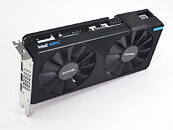
Intel Posts Disassembly and PCB Shots of Arc A770 Limited Edition
Intel Graphics, in its latest teaser video to the Arc A770 Limited Edition "Alchemist" graphics card, posted detailed renders of the card disassembled. The card features a strictly dual-slot cooling solution that uses an aluminium base-plate and a copper vapor-chamber to pull heat from the various hot components of the PCB. This is conveyed by four flat copper heat pipes through an aluminium fin-stack heatsink, which is ventilated by a pair of 80 mm fans. The cooler and its backplate feature four independent RGB lighting zones—the bores of each of the two fans, a light strip running along the top of the card; and toward the tail-end of the backplate, with a total of 90 LEDs. Intel claims that the maximum noise output of the cooler is 39 dBA.
The PCB is shorter in length than the cooler itself, and is full-height (and no taller). It draws power from a combination of 8-pin and 6-pin PCIe power connectors, which combined with slot-power add up to 300 W. A 6-phase VRM powers the "ACM-G10" GPU, while there are three other VRM phases, which could power the eight GDDR6 memory chips, and other power domains of the card. Display outputs include three standard-size DisplayPort 2.0, and one HDMI 2.1. The card's host interface is PCI-Express 4.0 x16, and although not a system requirement, Intel insists that the card be used on a machine with PCI resizable-BAR enabled.
The PCB is shorter in length than the cooler itself, and is full-height (and no taller). It draws power from a combination of 8-pin and 6-pin PCIe power connectors, which combined with slot-power add up to 300 W. A 6-phase VRM powers the "ACM-G10" GPU, while there are three other VRM phases, which could power the eight GDDR6 memory chips, and other power domains of the card. Display outputs include three standard-size DisplayPort 2.0, and one HDMI 2.1. The card's host interface is PCI-Express 4.0 x16, and although not a system requirement, Intel insists that the card be used on a machine with PCI resizable-BAR enabled.



























































